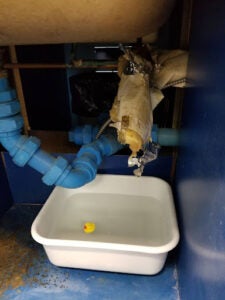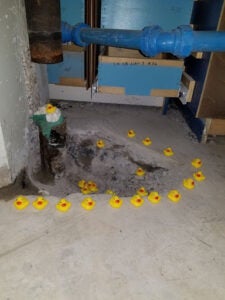Aiden Farrant
 Occupation of Dalhousie’s historic Chemistry Building by diligent and industrious teaching assistants, course markers, and part-time academics dates back to its conception as the Science Building in 1915. In the century and change following its completion, the revisions and additions (such as the 1964-1965 connection to the MacDonald building dubbed “new chemistry” and the 1985 podium or “new new chemistry”, where most wet lab instruction takes place) have not always been as interconnected as hoped. The space is plagued by flooding, power surges, potentially inhospitable air, accessibility constraints, and a plethora of hostile design choices. The following article details testimonials from CUPE 3912 members who have delivered course content in this treacherous space and have escaped out the back door (unfortunately leading to the Dunn parking lot, what a view!).
Occupation of Dalhousie’s historic Chemistry Building by diligent and industrious teaching assistants, course markers, and part-time academics dates back to its conception as the Science Building in 1915. In the century and change following its completion, the revisions and additions (such as the 1964-1965 connection to the MacDonald building dubbed “new chemistry” and the 1985 podium or “new new chemistry”, where most wet lab instruction takes place) have not always been as interconnected as hoped. The space is plagued by flooding, power surges, potentially inhospitable air, accessibility constraints, and a plethora of hostile design choices. The following article details testimonials from CUPE 3912 members who have delivered course content in this treacherous space and have escaped out the back door (unfortunately leading to the Dunn parking lot, what a view!).

The first experience of a new fall term for teaching assistants in the first-year chemistry program is a primer on what to do if a student under their purview is to faint. The blistering heat on the brutalist concrete ceiling and rain-stained windows of the Chemistry Podium is barely compensated for by the sometimes operational climate control system. Chemistry TAs, being lucky that they get any job-specific orientation at all (most departments adopt the “run before you can walk” mentality when it comes to instruction), are told to watch for the characteristic signs of a new student, still acclimatizing to the university experience, succumbing to the soupy atmosphere amid shattering glassware, pristine white lab coats adorned with Dalhousie bookstore price tags, and the general uncertainty about where to be in an active lab space. In the author’s experience, catching a fainting student before they hit the floor (or worse conk their heads on a lab bench) is a must, lest a panic-induced chain reaction occur. This unfortunate circumstance has led to mass evacuations and independent air quality assessments, as a building as decrepit as this can never truly be trusted.
 Once the sun turns to rain and hurricane season rolls around, delivering lab content can become a swimming lesson. The charismatic lab coordinator, equipped with an armada of “safety ducks” manages the herculean task of wrangling repairs as flood water pours in from all sides. It is not uncommon to have to manage roof and window leaks, flood water ingress from safety exits, and water pushing up floor tiles, all while trying to instill safe lab practices into tomorrow’s scientists and medical experts. Wet floor signs are not a transient presence, rather a permanent fixture and the persistent leaks are now considered a value-adding “water feature” (think Frank Lloyd Wright!). The organic chemistry team even once included their mop and bucket on their “meet the TAs” website owing to its frequent use.
Once the sun turns to rain and hurricane season rolls around, delivering lab content can become a swimming lesson. The charismatic lab coordinator, equipped with an armada of “safety ducks” manages the herculean task of wrangling repairs as flood water pours in from all sides. It is not uncommon to have to manage roof and window leaks, flood water ingress from safety exits, and water pushing up floor tiles, all while trying to instill safe lab practices into tomorrow’s scientists and medical experts. Wet floor signs are not a transient presence, rather a permanent fixture and the persistent leaks are now considered a value-adding “water feature” (think Frank Lloyd Wright!). The organic chemistry team even once included their mop and bucket on their “meet the TAs” website owing to its frequent use.
Finally, when the water outside starts to freeze and seal up all the nooks and crannies, the accessibility failings of the space become apparent. The fire exits, of which there are not enough, are rarely shoveled free of snow. When they are, students would still be expected to climb frozen concrete stairs or tread across uneven ground. Thankfully, when the winter ice storms hit, power outages and snow days inhibit lab operation enough that cancellations limit the actual number of delivered sessions. Unfortunately, the surge in students from a canceled session are then smeared across all the other (usually full) delivery dates, leading a TA to wonder if they truly count toward the fire marshall’s occupancy limit. After all, we are TAs first, not people.
I could drone on about the anecdotal experience I’ve collected from my peers, like the ceiling and wall cracks in the analytical space so large you could stick your hand through, or students in organic asking for an accessible fume hood and being given a stool in front of a fuming waste container, or the countless bottles of fuming violent red nitric oxide thrust into many a TA’s face, but the picture is already clear. The space, designed at the latest for 1980s needs, is hostile to anyone attempting to deliver a comprehensive and complete pedagogical experience in chemistry. The community, both within CUPE 3912 and with other campus unions and associations is incredibly heartwarming (adding to the already sweaty space), and there is much experience and satisfaction to be gained in the positions available, but applicants beware when requesting a posting within. This building makes safe and resourceful chemists, but out of necessity rather than offering potential.
 Aiden Farrant is a PhD Candidate in Chemistry at Dalhousie University. He is a Teaching Assistant for introductory chemistry labs at Dalhousie, and the Recording Secretary for CUPE 3912. According to the Communications Officer who wrote this bio, Aiden is very intelligent and highly competent, has a fantastic personality, is feared by University Legal Counsel, and is also extremely handsome.
Aiden Farrant is a PhD Candidate in Chemistry at Dalhousie University. He is a Teaching Assistant for introductory chemistry labs at Dalhousie, and the Recording Secretary for CUPE 3912. According to the Communications Officer who wrote this bio, Aiden is very intelligent and highly competent, has a fantastic personality, is feared by University Legal Counsel, and is also extremely handsome.
Photos are original content, or used with permission from anonymous sources.